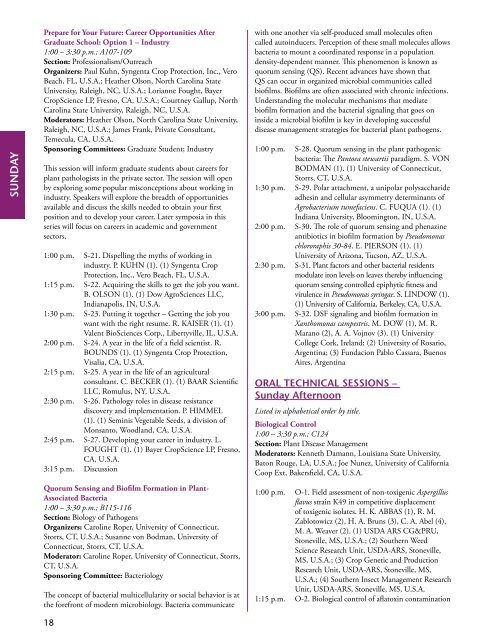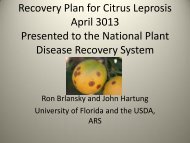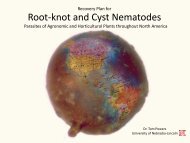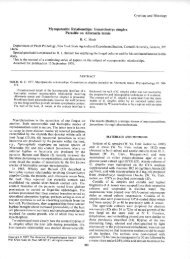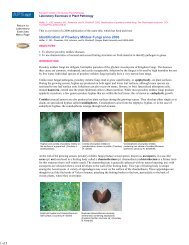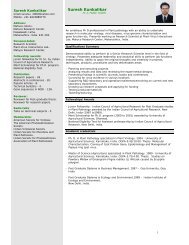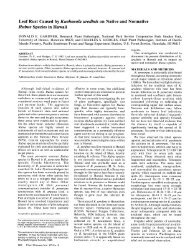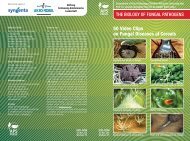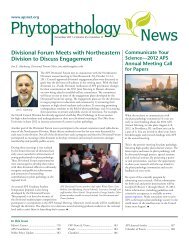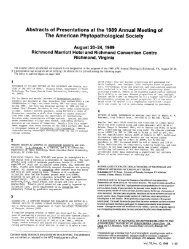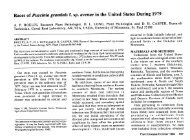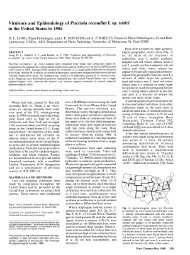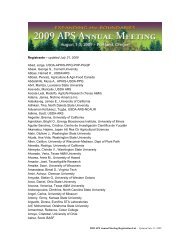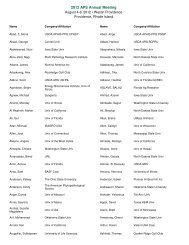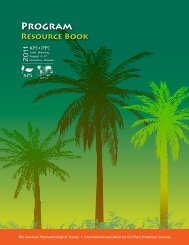Annual Meeting Program Book - American Phytopathological Society
Annual Meeting Program Book - American Phytopathological Society
Annual Meeting Program Book - American Phytopathological Society
You also want an ePaper? Increase the reach of your titles
YUMPU automatically turns print PDFs into web optimized ePapers that Google loves.
sundaY<br />
Prepare for Your Future: Career Opportunities After<br />
Graduate School: Option 1 – Industry<br />
1:00 – 3:30 p.m.; A107-109<br />
Section: Professionalism/Outreach<br />
Organizers: Paul Kuhn, Syngenta Crop Protection, Inc., Vero<br />
Beach, FL, U.S.A.; Heather Olson, North Carolina State<br />
University, Raleigh, NC, U.S.A.; Lorianne Fought, Bayer<br />
CropScience LP, Fresno, CA, U.S.A.; Courtney Gallup, North<br />
Carolina State University, Raleigh, NC, U.S.A.<br />
Moderators: Heather Olson, North Carolina State University,<br />
Raleigh, NC, U.S.A.; James Frank, Private Consultant,<br />
Temecula, CA, U.S.A.<br />
Sponsoring Committees: Graduate Student; Industry<br />
This session will inform graduate students about careers for<br />
plant pathologists in the private sector. The session will open<br />
by exploring some popular misconceptions about working in<br />
industry. Speakers will explore the breadth of opportunities<br />
available and discuss the skills needed to obtain your first<br />
position and to develop your career. Later symposia in this<br />
series will focus on careers in academic and government<br />
sectors.<br />
1:00 p.m. S-21. Dispelling the myths of working in<br />
industry. P. KUHN (1). (1) Syngenta Crop<br />
Protection, Inc., Vero Beach, FL, U.S.A.<br />
1:15 p.m. S-22. Acquiring the skills to get the job you want.<br />
B. OLSON (1). (1) Dow AgroSciences LLC,<br />
Indianapolis, IN, U.S.A.<br />
1:30 p.m. S-23. Putting it together – Getting the job you<br />
want with the right resume. R. KAISER (1). (1)<br />
Valent BioSciences Corp., Libertyville, IL, U.S.A.<br />
2:00 p.m. S-24. A year in the life of a field scientist. R.<br />
BOUNDS (1). (1) Syngenta Crop Protection,<br />
Visalia, CA, U.S.A.<br />
2:15 p.m. S-25. A year in the life of an agricultural<br />
consultant. C. BECKER (1). (1) BAAR Scientific<br />
LLC, Romulus, NY, U.S.A.<br />
2:30 p.m. S-26. Pathology roles in disease resistance<br />
discovery and implementation. P. HIMMEL<br />
(1). (1) Seminis Vegetable Seeds, a division of<br />
Monsanto, Woodland, CA, U.S.A.<br />
2:45 p.m. S-27. Developing your career in industry. L.<br />
FOUGHT (1). (1) Bayer CropScience LP, Fresno,<br />
CA, U.S.A.<br />
3:15 p.m. Discussion<br />
Quorum Sensing and Biofilm Formation in Plant-<br />
Associated Bacteria<br />
1:00 – 3:30 p.m.; B115-116<br />
Section: Biology of Pathogens<br />
Organizers: Caroline Roper, University of Connecticut,<br />
Storrs, CT, U.S.A.; Susanne von Bodman, University of<br />
Connecticut, Storrs, CT, U.S.A.<br />
Moderator: Caroline Roper, University of Connecticut, Storrs,<br />
CT, U.S.A.<br />
Sponsoring Committee: Bacteriology<br />
The concept of bacterial multicellularity or social behavior is at<br />
the forefront of modern microbiology. Bacteria communicate<br />
18<br />
with one another via self-produced small molecules often<br />
called autoinducers. Perception of these small molecules allows<br />
bacteria to mount a coordinated response in a population<br />
density-dependent manner. This phenomenon is known as<br />
quorum sensing (QS). Recent advances have shown that<br />
QS can occur in organized microbial communities called<br />
biofilms. Biofilms are often associated with chronic infections.<br />
Understanding the molecular mechanisms that mediate<br />
biofilm formation and the bacterial signaling that goes on<br />
inside a microbial biofilm is key in developing successful<br />
disease management strategies for bacterial plant pathogens.<br />
1:00 p.m. S-28. Quorum sensing in the plant pathogenic<br />
bacteria: The Pantoea stewartii paradigm. S. VON<br />
BODMAN (1). (1) University of Connecticut,<br />
Storrs, CT, U.S.A.<br />
1:30 p.m. S-29. Polar attachment, a unipolar polysaccharide<br />
adhesin and cellular asymmetry determinants of<br />
Agrobacterium tumefaciens. C. FUQUA (1). (1)<br />
Indiana University, Bloomington, IN, U.S.A.<br />
2:00 p.m. S-30. The role of quorum sensing and phenazine<br />
antibiotics in biofilm formation by Pseudomonas<br />
chlororaphis 30-84. E. PIERSON (1). (1)<br />
University of Arizona, Tucson, AZ, U.S.A.<br />
2:30 p.m. S-31. Plant factors and other bacterial residents<br />
modulate iron levels on leaves thereby influencing<br />
quorum sensing controlled epiphytic fitness and<br />
virulence in Pseudomonas syringae. S. LINDOW (1).<br />
(1) University of California, Berkeley, CA, U.S.A.<br />
3:00 p.m. S-32. DSF signaling and biofilm formation in<br />
Xanthomonas campestris. M. DOW (1), M. R.<br />
Marano (2), A. A. Vojnov (3). (1) University<br />
College Cork, Ireland; (2) University of Rosario,<br />
Argentina; (3) Fundacion Pablo Cassara, Buenos<br />
Aires, Argentina<br />
oral TeChnICal sessIons –<br />
sunday afternoon<br />
Listed in alphabetical order by title.<br />
Biological Control<br />
1:00 – 3:30 p.m.; C124<br />
Section: Plant Disease Management<br />
Moderators: Kenneth Damann, Louisiana State University,<br />
Baton Rouge, LA, U.S.A.; Joe Nunez, University of California<br />
Coop Ext, Bakersfield, CA, U.S.A.<br />
1:00 p.m. O-1. Field assessment of non-toxigenic Aspergillus<br />
flavus strain K49 in competitive displacement<br />
of toxigenic isolates. H. K. ABBAS (1), R. M.<br />
Zablotowicz (2), H. A. Bruns (3), C. A. Abel (4),<br />
M. A. Weaver (2). (1) USDA ARS CG&PRU,<br />
Stoneville, MS, U.S.A.; (2) Southern Weed<br />
Science Research Unit, USDA-ARS, Stoneville,<br />
MS, U.S.A.; (3) Crop Genetic and Production<br />
Research Unit, USDA-ARS, Stoneville, MS,<br />
U.S.A.; (4) Southern Insect Management Research<br />
Unit, USDA-ARS, Stoneville, MS, U.S.A.<br />
1:15 p.m. O-2. Biological control of aflatoxin contamination


